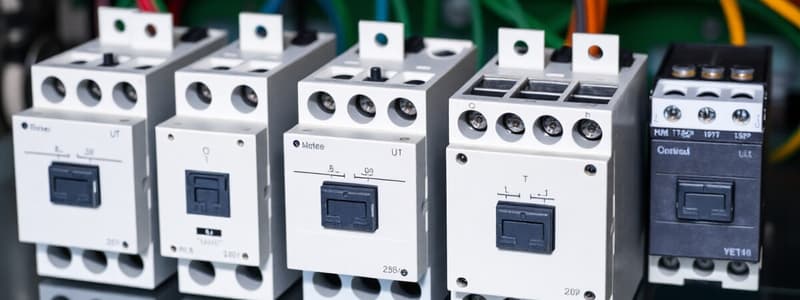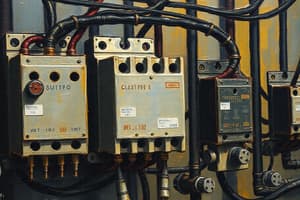Podcast
Questions and Answers
Which characteristic defines a contactor (sklopnik)?
Which characteristic defines a contactor (sklopnik)?
- Manual operation with direct physical contact.
- Energy-driven (remote) operation using electromagnets or pneumatics. (correct)
- Exclusively used for short-circuit protection.
- Limited to low-voltage circuits only.
What is the primary function of auxiliary contactors?
What is the primary function of auxiliary contactors?
- Handling overload and short-circuit conditions.
- Controlling and switching operational currents. (correct)
- Providing a visual indication of the circuit status.
- Switching main power circuits directly.
What is the main purpose of a 'Rastavljač' (Disconnector) in electrical installations?
What is the main purpose of a 'Rastavljač' (Disconnector) in electrical installations?
- To regulate voltage levels within the network.
- To automatically interrupt the circuit under fault conditions.
- To create a safe isolation gap for maintenance in open circuit. (correct)
- To provide remote control of circuit breakers.
What is the key difference between 'sklopke' (switches) and 'prekidači' (circuit breakers)?
What is the key difference between 'sklopke' (switches) and 'prekidači' (circuit breakers)?
If a contactor is rated for 25 A, what does this rating signify?
If a contactor is rated for 25 A, what does this rating signify?
Within which voltage range do 'niskonaponski' (low voltage) sklopni aparati typically operate?
Within which voltage range do 'niskonaponski' (low voltage) sklopni aparati typically operate?
What is the purpose of 'odvodnici prenapona' (surge arresters) in electrical systems?
What is the purpose of 'odvodnici prenapona' (surge arresters) in electrical systems?
In a typical installation, where should an 'Instalacijska sklopka' (installation switch) be connected for optimal safety?
In a typical installation, where should an 'Instalacijska sklopka' (installation switch) be connected for optimal safety?
What characteristic defines a 'bimetalni relej' (bimetallic relay)?
What characteristic defines a 'bimetalni relej' (bimetallic relay)?
What is the function of a 'tipkalo'?
What is the function of a 'tipkalo'?
Flashcards
What is a Contactor?
What is a Contactor?
Device with remote operation of moving contacts, using electromagnetism or pneumatics.
Parts of a Contactor
Parts of a Contactor
Main contacts, auxiliary contacts, magnetic coil, arc extinguishing chambers.
Types of Contactors
Types of Contactors
Smaller contactors for control circuits. Larger contactors that handles more power.
Contactor Specifications
Contactor Specifications
Signup and view all the flashcards
What is a Relay?
What is a Relay?
Signup and view all the flashcards
Types of Relays
Types of Relays
Signup and view all the flashcards
Connecting Installation Switches
Connecting Installation Switches
Signup and view all the flashcards
Electrical Switch
Electrical Switch
Signup and view all the flashcards
Types of switch operation
Types of switch operation
Signup and view all the flashcards
Disconnectors
Disconnectors
Signup and view all the flashcards
Study Notes
- The topic is Sklopnici (Contactors), a device with energetic (remote) activation of moving contacts via electromagnet or pneumatics
General info
- It is a special type of switch, able to switch in normal operation and in overload
- If it can switch remotely, it is called a remote switch
Parts of a contactor:
- Main
- Auxiliary
- Magnetic coil for control
- Arc extinguishing chambers
Types of contactors:
- Auxiliary contactors used for switching control circuits
- Main contactors
- Smaller contactors are for currents up to 25 A
- Larger ones are for currents of 2500 A and voltages of 1 kV ~, 1.5 kV=
- Contactors enable 3,000 switches per hour
Basic contactor data:
- Nominal voltage
- Rated current (or power)
- Rated thermal capacity, i.e., the maximum current the contactor can conduct during 8-hour operation
- Contactors require a pre-fuse device for short-circuit protection
Connection markings of main contactors:
- Connection of the coil (A1, A2)
- Main contacts: 1, 3, 5, 2, 4, 6
- Auxiliary contacts: 13, 21, 14, 22
Contact functions:
- Disconnecting
- Connecting
- Alternating
Coil types:
- Single winding with markings A1 and A2
- With a tap: A1, A2, A3
- Double winding: A1, A2, B1, B2
Applications of contactors:
- Installation contactors for lighting, heating, etc
- Motor contactors
Relays and auxiliary contactors:
- A relay is a device that, depending on the change of a physical quantity, causes changes in the same or another electrical circuit
Types of relays:
- Measuring relays: measure the operating quantity and open and close contacts, use primarily for protection
- Auxiliary relays: are similar to measuring ones, but smaller in size, intended for use in auxiliary circuits
- Time relays: used to set the triggering time
Relay and contactor contacts:
- Connecting
- Disconnecting
- Alternating
- Instantaneous (connecting-disconnecting)
Bimetallic relays:
- Bimetallic relays are overcurrent thermal relays with a current-dependent characteristic based on the heating of a bimetallic strip
Bimetallic relays exist with:
- Classic mechanical current protection design
- Electronic current protection design for larger currents
Installation switches:
- Installation switches are used to switch devices on and off
- They connect, continuously conduct and break currents of normal operation and possible overloads
They can briefly conduct short-circuit current
- Mode of operation: Installation switches can work with
- Position - without restoring force, manual switching on and off, lever, cam, hinged
- Impulse - with restoring force (button for staircase lighting)
- Locking (automatic switch)
Types of drives:
- Manual
- Mechanical
Arc extinguishing methods:
- Air
- Oil
- Magnetic
- Vacuum
Purpose of installation switches:
- Protective
- Command
- Limit (pressure, level switches)
- Auxiliary
Installation switches:
- Buttons can be hinged, rotary, pressure, or pull
Installation switches:
- Mostly used for lighting control: 230V, 50-60 Hz in a three-wire single-phase system (L, N, PE conductors).
Installation types:
- Flush-mounted
- Surface-mounted
- Built into devices
Connection methods:
- Single-pole
- Double-pole
- Series
- Alternating
- Cross
Installation switches:
- General version - IP 20 or IP 40
- Waterproof version - IP 44, IP 65, mostly IP 55
Installation
- Installation switches are always connected to the phase conductor
- The threaded part in the lamp socket, into which the bulb is screwed, must not be connected to the phase conductor - the phase conductor is connected to the central contact of the socket
- The switch can interrupt the neutral conductor, but this must be simultaneous with the phase, or after the phase is interrupted
During switch-on:
- Reverse order
- The protective conductor is connected to the housing
- Switches are 1.5 m from the ground, and pull switches are 2.25 m from the ground
Switchgear (devices) - are devices used to close and open electrical circuits
- Some can switch on and off certain currents of normal and abnormal operating conditions, while others cannot
- Used for establishing, maintaining and interrupting the continuity or discontinuity of electrical circuits
Switches:
- Used for switching, continuous conduction and interruption of normal operating currents and possible overloads, and can also conduct short-circuit currents very briefly
- Circuit breakers can switch on, conduct and switch off currents up to the limit values of the short-circuit current
Disconnectors
- Disconnectors have the task of creating a separating gap that will ensure the safety of personnel and equipment
- They are used for opening and closing energized electrical circuits and can continuously conduct a current of normal operation
- They can withstand a short-circuit current for a short time interval and are mainly used in switchgear
Starters:
- Serve to start motors or start other equipment and allow operating parameters to remain within specified limits
- Regulators allow some operating or working values to remain at approximately constant values
Fuses:
- Automatically interrupt the electrical circuit when the current exceeds the permissible value
Surge arresters:
- Used to protect electrical installations from surges and are usually connected between electrical conductors and earth
- They limit the level of surge voltages
- Relays are devices that measure an operating quantity (current, voltage, pressure, temperature,...) and, at a certain value, automatically close or open their contacts, thus enabling the control of further devices
- A relay is a type of command switch
- Connection devices (accessories) are types of switchgear whose parts for connection and separation are not rigidly fixed on one base (sockets and plugs)
- It can be said that in electrical installations they also play a role similar to disconnectors
- Switch blocks are actually groups of different switchgear, and are most often placed in distribution cabinets, control tables, etc
Switchgear - according to rated voltage:
- Low voltage - up to 1000 V
- High voltage - over 1000 V
Terms related to switchgear:
- The pole of a device is the part of the switchgear that belongs to one active conductor of an alternating system or one polarity of a direct current system
- Actuation or activation current is the amount of current that must flow for a certain time after which the switchgear operates
- The protective element is a switchgear that switches off an electrical circuit upon the occurrence of a specific harmful stimulus
- The button is a switchgear used for manual short-term connection or disconnection of contacts
- Release is part of a switchgear that, when a certain electrical magnitude (less often some other physical magnitude) changes, releases the accumulated energy required to close or open the contact
- The energy is most often accumulated in a tensioned spring or compressed air
- In switchgear, overcurrent (bimetallic or electromagnetic), undervoltage and voltage releases are most commonly encountered
- Making capacity is the highest peak value of the current that the device can switch on with a certain voltage and under certain operating conditions without welding of the contact elements and mechanical distortion
- Breaking (switching) power is the effective value of the current that the device can break with a certain voltage and power factor, and without the occurrence of a arcing effect between the contacts
Studying That Suits You
Use AI to generate personalized quizzes and flashcards to suit your learning preferences.




